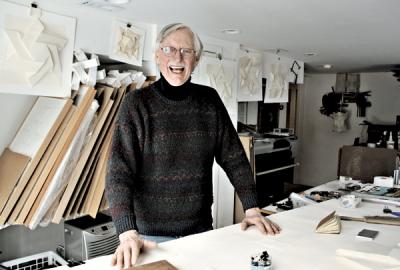Juxtaposing Planes and Angles

What, you may well ask, could possibly be the connection between a lunar rover and bas-relief sculpture made by folding paper?
On its face, there does not seem to be one, but once the demands of engineering and architecture are considered, a thread of continuity appears.
Nils Bruun, a resident of Springs and New York City, seems to approach both disciplines as puzzles to be solved. After earning a degree in mechanical engineering at Rensselaer Polytechnic Institute, he worked at Grumman as part of a team that had to come up with new projects for NASA, one of which was to devise a way to design a vehicle the size of a car, so that it would fit into a lunar lander, but with a big wheelbase. He had to figure out how to fold it in order to make it compact enough to fit in the lander.
At the same time Mr. Bruun was working on a lot of planes, designing slats and flaps that come out of the wing. He did this kind of work for 10 years, “making something smaller from something bigger,” as he put it, but then became interested in going back to school. He got into a master’s program in environmental design at the Yale School of Architecture, where he did sculpture and some architecture. He also got into folding paper, which is an exercise given to architecture students who are asked to make a structure out of a piece of paper. While reverse-engineering some of the more abstract projects he was working on, Mr. Bruun started “learning all kinds of things about folding paper,” he said recently at his house on Gardiner’s Bay in Springs.
At the end of the 1980s and 1990s, after making forays into teaching — at the Rhode Island School of Design, where he designed lamps out of folded plastic — doing design work as a consultant and contractor, working at I.B.M. helping physicists design experiments, and doing industrial design work making closures for computer hard drives, Mr. Bruun knew that he wanted to get back to folding paper. It almost seems as if, all that time, bouncing back and forth between an academic environment and the practical world, Mr. Bruun was looking for a way to combine architecture and engineering, engineering being the nuts and bolts and architecture being the aesthetics.
He also started sculpting in wood and metal, learning to fold sheet metal along perforated lines.
“Paper folding is sculpture,” Mr. Bruun said, “bas-relief sculpture.” It is similar to painting in the sense that he fits a low (usually) bas-relief form within the rectangular shape of a wooden frame. “Variations on Gardiner’s Bay,” for example, which hangs in his hallway, has nine bas-reliefs in 12-by-12-inch frames, each one a sculpture folded from one piece of paper. In this work each sculpture is one of the many colors in the water and sky, which are visible from the huge picture window in the living room.
Mr. Bruun uses heavier paper for bigger pieces and lighter paper for smaller ones. Some of the lighter, thinner paper looks remarkably like fabric, silk even. What is difficult to imagine is how he is able to achieve such symmetry by folding one sheet of paper, without a single cut.
Pamela Williams, whose Amagansett gallery represented Mr. Bruun’s work, referred to “the light and shadow, the purity, of his work.” She said he can “see things on multiple planes and can play with them; the aesthetic is Eastern. His work is striking and sophisticated.”
But does he really see things multi-dimensionally? Mr. Bruun said he has no depth perception because of a condition called strabismus, which allows him to see things with only one eye at a time. “If I turn my head slightly and look at the object, then it’s the same as if I were seeing it with both eyes at once, with integrated vision.” His bas-relief sculpture seems almost an attempt to turn something three-dimensional into something two-dimensional. “People say,” said Mr. Bruun, that “we do something in our life to overcome a handicap that we have.”
He seems to approach the work as an engineering problem. “How can I change this using the same basic pattern for folding so that it doesn’t look like this?” He manipulates the material to produce a different effect. “The aim is usually what happens if I do this? Then I try and see if I can make it work. There are a lot of not so good attempts that get recycled, but that is the nature of the beast.”
Each piece looks different from the back. Does he think of showing both sides? “No,” he said, “I have one side in mind, and then I look at what the other side looks like, and sometimes that is the better side. If I like both sides, I show them both.”
The folding techniques and concepts have been translated into folded plastic lamps, wood and metal sculptures, and a line of clothing Mr. Bruun is developing with a business partner who became a costumer designer while studying at the Yale School of Drama.
Mr. Bruun’s work is in many private collections and has been shown at the Julie Artisans Gallery in New York and other galleries on the East End, as well as the Pamela Williams Gallery, and in Connecticut. In addition to studying at the New School and the Art Students League, he has also taught at the Yale School of Architecture, Northern Illinois University, and the Art Barge.
